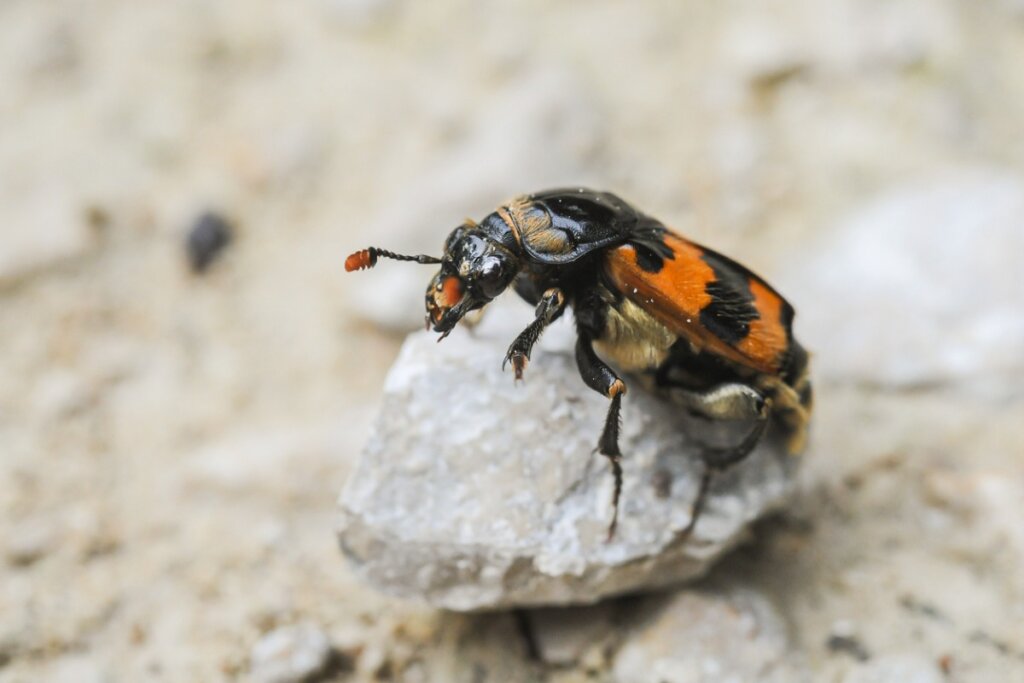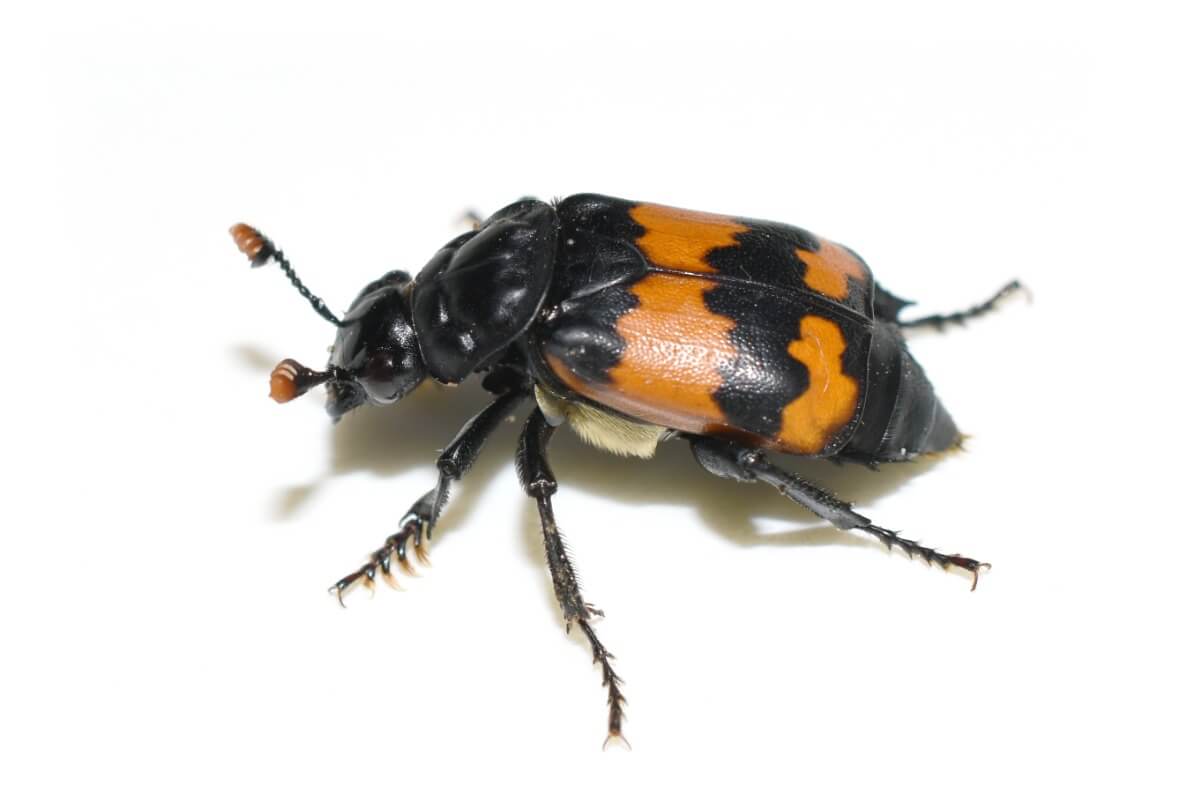How Burying Beetles Protect Their Food

Beetles are a very popular group of insects because of their shape and coloration. However, they also exhibit peculiar behavior patterns that make them very surprising specimens. An example of this are the burying beetles, as they show extremely curious behavior when trying to protect their food.
These organisms belong to the Silphidae family, which is made up of beetles with necrophagous habits. Only two specific genera, Silpha and Nicrophorus, are known as burying beetles. If you want to know what these organisms do to protect their food, keep reading this article.
What are burying beetles?
The body of these beetles is quite small, ranging from 4 to 40 millimeters in length. In addition, their appearance is flattened and slightly elongated. They are black with diverse patterns and have red or yellow spots.
They also have 3 pairs of legs with claws at the end of each one, which helps them to move different portions of their food. This is very useful for them, as their diet is based on decaying animals (a necrophagous diet), so they need a good grip to transport their food.
As if that weren’t enough, these beetles have an excellent ability to locate their food, as they detect dead animals even at great distances. To do this, they have a great sense of smell, with which they detect the chemical particles that are released by decomposing matter. Thanks to this, the beetles easily identify the remains of animals and begin to feast on them.
However, the most striking feature of this insect is its ability to protect its food. This is because it uses a strategy similar to that of the dung beetle, but with certain modifications that make it different from any other beetle.

How do beetles protect their food?
Burying beetles process their food before feeding on it, as they need to remove feathers and surface hairs. In addition, all this debris is compacted into a kind of ball that makes it much easier to transport. In this way, they move this mass (which is bigger than them) by rolling it to their hiding place, thus obtaining a large reserve to last for a long period.
This process requires a titanic effort, as the beetle produces an antibacterial substance that slows down the rate of decomposition. A study by the University of Connecticut study showed that this curious insect does this in order to prevent the dead animal from attracting other competitors. Thanks to this, the beetle doesn’t have to worry about its food reserves being stolen.
In addition, this strategy also serves another purpose, as in the case of Nicrophorus orbicollis, the process enables it to store part of the food for its offspring. An article published in the scientific journal Animal Behaviour mentions that the beetle deposits its young under the dead matter so that they can feed on it when they’re born.
In this way, the parents can devote themselves entirely to caring for their offspring, since they’re assured of an enormous food supply for them.
How do they manage to eat animal carcasses?
In order to feed on animal carcasses, these insects had to go to extraordinary lengths to adapt. Unlike vultures, the beetles’ strategy is to use antimicrobial substances. Thanks to this, they avoid contracting any type of disease or toxin that could be lethal to them.
In short, the digestive system of these organisms is specialized in destroying harmful bacteria. To do this, they secrete antibiotic-like substances and enzymes that destroy any toxic compounds. However, they only achieve this by forming an alliance with beneficial bacteria, yeasts, and other microorganisms that live in their gut.
This means that the antibacterial substances serve as a kind of preservative, as the beetles prevent the food from decomposing.
United against invaders
These beetles’ incredible strategies don’t end here, because they also enlist the help of other arthropods to protect their food. Some burying beetles associate with mites (Poecilochirus carabi), thus generating a mutualistic symbiotic relationship.
The mites are transported by the beetles to their carrion and feed on the fly eggs that are present on the dead animal. Thanks to this, the beetles’ food is disinfected, while the small mites feast on the fly hatchlings. In this way, they manage to clean the food supply in a better way.
As you can see, burying beetles do an incredible job to protect their food. This is due to the great challenges they face as they fight against other organisms in order to hoard their food. In this way, not only do the adults end up benefiting, but they also ensure the survival of their young. Without a doubt, small insects are more amazing than you think.
All cited sources were thoroughly reviewed by our team to ensure their quality, reliability, currency, and validity. The bibliography of this article was considered reliable and of academic or scientific accuracy.
- Nehring, V., Müller, J. K., & Steinmetz, N. (2017). Phoretic Poecilochirus mites specialize on their burying beetle hosts. Ecology and evolution, 7(24), 10743-10751.
- Trumbo, S. T. (2017). Feeding upon and preserving a carcass: the function of prehatch parental care in a burying beetle. Animal Behaviour, 130, 241-249.
- Vogel, H., Shukla, S. P., Engl, T., Weiss, B., Fischer, R., Steiger, S., … & Vilcinskas, A. (2017). The digestive and defensive basis of carcass utilization by the burying beetle and its microbiota. Nature communications, 8(1), 1-15.
- Trumbo, S. T., Philbrick, P. K., Stökl, J., & Steiger, S. (2021). Burying beetle parents adaptively manipulate information broadcast from a microbial community. The American Naturalist, 197(3), 366-378.
- Galindo-Rojas, D. V., Carrasco, M. G. V., & López, J. A. ABUNDANCIA DEL ESCARABAJO ENTERRADOR Nicrophorus mexicanus, Matthews (COLEOPTERA: SILPHIDAE) EN LA SIERRA DEL NAYAR, DURANGO, MÉXICO.
